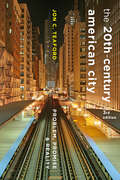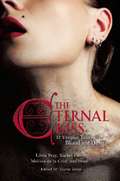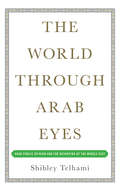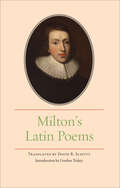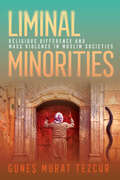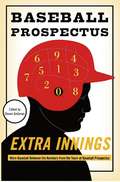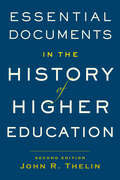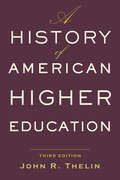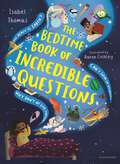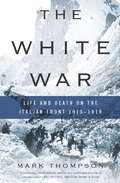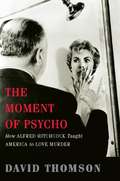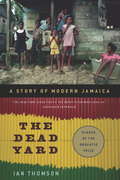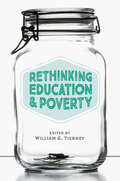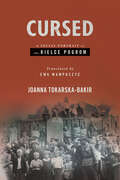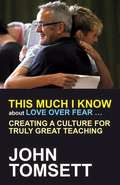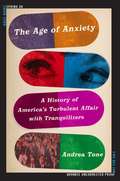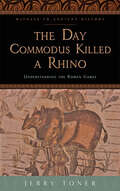- Table View
- List View
The Twentieth-Century American City: Problem, Promise, and Reality (The American Moment)
by Jon C. TeafordThroughout the twentieth century, the city was deemed a problematic space, one that Americans urgently needed to improve. Although cities from New York to Los Angeles served as grand monuments to wealth and enterprise, they also reflected the social and economic fragmentation of the nation. Race, ethnicity, and class splintered the metropolis both literally and figuratively, thwarting efforts to create a harmonious whole. The urban landscape revealed what was right;¢;‚¬;€?and wrong;¢;‚¬;€?with both the country and its citizens;€™ way of life. In this thoroughly revised edition of his highly acclaimed book, Jon C. Teaford updates the story of urban America by expanding his discussion to cover the end of the twentieth century and the first years of the next millennium. A new chapter on urban revival initiatives at the close of the century focuses on the fight over suburban sprawl as well as the mixed success of reimagining historic urban cores as hip new residential and cultural hubs. The book also explores the effects of the late-century immigration boom from Latin America and Asia, which has complicated the metropolitan ethnic portrait.Drawing on wide-ranging primary and secondary sources, Teaford describes the complex social, political, economic, and physical development of US urban areas over the course of the long twentieth century. Touching on aging central cities, technoburbs, and the ongoing conflict between inner-city poverty and urban boosterism, The Twentieth-Century American City offers a broad, accessible overview of America;€™s persistent struggle for a better city.
The Twentieth-Century American City: Problem, Promise, and Reality (The American Moment)
by Jon C. TeafordThroughout the twentieth century, the city was deemed a problematic space, one that Americans urgently needed to improve. Although cities from New York to Los Angeles served as grand monuments to wealth and enterprise, they also reflected the social and economic fragmentation of the nation. Race, ethnicity, and class splintered the metropolis both literally and figuratively, thwarting efforts to create a harmonious whole. The urban landscape revealed what was right;¢;‚¬;€?and wrong;¢;‚¬;€?with both the country and its citizens;€™ way of life. In this thoroughly revised edition of his highly acclaimed book, Jon C. Teaford updates the story of urban America by expanding his discussion to cover the end of the twentieth century and the first years of the next millennium. A new chapter on urban revival initiatives at the close of the century focuses on the fight over suburban sprawl as well as the mixed success of reimagining historic urban cores as hip new residential and cultural hubs. The book also explores the effects of the late-century immigration boom from Latin America and Asia, which has complicated the metropolitan ethnic portrait.Drawing on wide-ranging primary and secondary sources, Teaford describes the complex social, political, economic, and physical development of US urban areas over the course of the long twentieth century. Touching on aging central cities, technoburbs, and the ongoing conflict between inner-city poverty and urban boosterism, The Twentieth-Century American City offers a broad, accessible overview of America;€™s persistent struggle for a better city.
The Eternal Kiss: 12 Vampire Tales of Blood and Desire
by Trisha TelepThere's an allure to vampire tales that have seduced readers for generations. From Bram Stoker to Stephanie Meyer and beyond, vampire stories are here to stay. For those fresh-blooded fans of paranormal romance or for those whose hunt and hunger never dies, these stories have what readers want!This collection of original tales comes from some of the hottest, most popular, and best-selling YA writers, including: Holly Black (The Spiderwick Chronicles, Tithe) Libba Bray (A Great and Terrible Beauty) Melissa De La Cruz (Blue Blood) Cassandra Clare (City of Bones) Rachel Caine (Morganville Vampires) Nancy Holder & Debbie Viguie (Wicked) Cecil Castellucci (Boy Proof, Queen of Cool) Kelley Armstrong (Women of Otherworld) Maria V. Snyder Sarah Rees Brennan Lili St. Crow Karen Mahoney Dina JamesThey will make everyone a sucker for eternal kisses.
The Eternal Kiss: 12 Vampire Tales of Blood and Desire
by Trisha TelepThere's an allure to vampire tales that have seduced readers for generations. From Bram Stoker to Stephanie Meyer and beyond, vampire stories are here to stay. For those fresh-blooded fans of paranormal romance or for those whose hunt and hunger never dies, these stories have what readers want! This collection of original tales comes from some of the hottest, most popular, and best-selling YA writers, including: Holly Black (The Spiderwick Chronicles, Tithe) Libba Bray (A Great and Terrible Beauty) Melissa De La Cruz (Blue Blood) Cassandra Clare (City of Bones) Rachel Caine (Morganville Vampires) Nancy Holder & Debbie Viguie (Wicked) Cecil Castellucci (Boy Proof, Queen of Cool) Kelley Armstrong (Women of Otherworld) Maria V. Snyder Sarah Rees Brennan Lili St. Crow Karen Mahoney Dina James They will make everyone a sucker for eternal kisses.
The World Through Arab Eyes: Arab Public Opinion and the Reshaping of the Middle East
by Shibley TelhamiThe uprisings that transformed the Middle East beginning in 2011 have left experts scrambling to understand where the region is likely to go in years to come. But missing from most of the analysis is a longer view of the evolution of Arab Public opinion and identity and how this is likely to influence this fast-changing region. In The World Through Arab Eyes, Shibley Telhami shows how the roots of these rebellions stretch back decades and explains how they will continue to affect the stability of the Middle East in the years to come. Telhami draws on a decade's worth of polling data and analysis to provide a comprehensive look at this evolution of Arab identity and opinion. The demand for dignity, which was foremost in the chants of millions of Arab demonstrators, went far beyond being a struggle for "food” and individual rights. Telhami identifies the key prisms through which Arabs view issues ranging from democracy and religion to foreign actors, including the United States, European and Asian countries, Iran, Turkey, and, centrally, Israel. These prisms provide a key to interpreting the past, comprehending the seismic changes in Arab politics today, and engaging with the region in the future.
Milton's Latin Poems
by Gordon TeskeyIn this collection, esteemed poet and translator David R. Slavitt brings to life John Milton’s Latin poetry with deft, imaginative modern English translations.While Milton is recognized as one of the most learned English poets in history, his Latin poetry is less well known. Slavitt’s careful rendering brings Milton’s Latin poems—many written in his late teens—into the present. He keeps true to the style of the originals, showing Milton’s maturing poetic voice and the freedom he found working in Latin. On the Gunpowder PlotO, sly Guy Fawkes, you plotted against your king and the British lords, but did you intend to be kindand make up for your malice in this thing with at least a show of piety? Do we findan intention, perhaps, of sending the members of court up to the sky in a chariot made of firethe way Elijah traveled. Or do I distort the simple wickedness of your desire?Featuring an introduction by Gordon Teskey, this comprehensive English-language collection of Milton’s Latin poems pays due respect to a master. Poetry lovers, Milton fans, and scholars of either will welcome, enjoy, and learn from this work.
The Dyslexia Handbook: Procedures Concerning Dyslexia and Related Disorders
by Texas Education AgencyThe Texas Education Agency (TEA) handbook contains the SBOE-approved procedures concerning dyslexia and related disorders. It provides guidelines for school districts to follow as they identify and provide services for students with dyslexia. Additionally, the handbook provides school districts and parents/guardians with information regarding the state's dyslexia statutes and their relation to these federal laws.
Liminal Minorities: Religious Difference and Mass Violence in Muslim Societies (Religion and Conflict)
by Günes Murat TezcürLiminal Minorities addresses the question of why some religious minorities provoke the ire of majoritarian groups and become targets of organized violence, even though they lack significant power and pose no political threat. Güneş Murat Tezcür argues that these faith groups are stigmatized across generations, as they lack theological recognition and social acceptance from the dominant religious group. Religious justifications of violence have a strong mobilization power when directed against liminal minorities, which makes these groups particularly vulnerable to mass violence during periods of political change.Offering the first comparative-historical study of mass atrocities against religious minorities in Muslim societies, Tezcür focuses on two case studies—the Islamic State's genocidal attacks against the Yezidis in northern Iraq in the 2010s and massacres of Alevis in Turkey in the 1970s and 1990s—while also addressing discrimination and violence against followers of the Bahá'í faith in Iran and Ahmadis in Pakistan and Indonesia. Analyzing a variety of original sources, including interviews with survivors and court documents, Tezcür reveals how religious stigmatization and political resentment motivate ordinary people to participate in mass atrocities.
Extra Innings: More Baseball Between the Numbers from the Team at Baseball Prospectus
by The Baseball ProspectusIn 1996, a brassy young team of fans produced a guide to baseball statistics. Printed on a photocopier, its distribution, which was in the low hundreds, was limited to friends, family, and die-hard stat heads. Sixteen years later, the Baseball Prospectus annual regularly hits best-seller lists and has become an indispensable guide for the serious fan. In Extra Innings, the team at Baseball Prospectus integrates statistics, interviews, and analysis to deliver twenty arguments about today&’s game. In the tradition of their seminal book, Baseball Between the Numbers, they take on everything from steroids to the amateur draft. They probe the impact of managers on the game. They explain the critical art of building a bullpen. In an era when statistics matter more than ever, Extra Innings is an essential volume for every baseball fan.
Extra Innings: More Baseball Between the Numbers from the Team at Baseball Prospectus
by The Baseball ProspectusIn 1996, a brassy young team of fansproduced a guide to baseball statistics.Printed on a photocopier, its distribution,which was in the low hundreds, was limited tofriends, family, and die-hard stat heads. Sixteenyears later, the Baseball Prospectus annualregularly hits best-seller lists and has becomean indispensable guide for the serious fan. In Extra Innings, the team at Baseball Prospectusintegrates statistics, interviews, and analysis todeliver twenty arguments about today's game.In the tradition of their seminal book, BaseballBetween the Numbers, they take on everything fromsteroids to the amateur draft. They probe theimpact of managers on the game. They explainthe critical art of building a bullpen. In an erawhen statistics matter more than ever, Extra Inningsis an essential volume for every baseball fan.
Essential Documents in the History of American Higher Education
by John R. ThelinThe thoroughly updated second edition of this dynamic and thoughtful collection focuses on the issues that have shaped American higher education in the past decade.Essential Documents in the History of American Higher Education, designed to be used alongside John R. Thelin's A History of American Higher Education or on its own, presents a rich collection of primary sources that chart the social, intellectual, political, and cultural history of American colleges and universities from the seventeenth century to the present. The documents are organized in sections that parallel the chapters in A History both chronologically and thematically, and sections are introduced with brief headnotes establishing the context for each source.This updated edition of Essential Documents focuses on the issues that have shaped American higher education in the past decade, from congressional investigations into endowments and court cases about paying student-athletes to accounts of campus protests over racial discrimination and adjuncts struggling in the "gig economy." From the successful fund-raising campaigns of 2014 to the closing of campuses because of the COVID-19 pandemic of 2020, the book also includes• a new tenth chapter, "Prominence and Problems: American Higher Education since 2010," and an updated introduction;• a number of landmark documents, including the charter for the College of Rhode Island (1764), the Morrill Land Grand Act (1862), the GI Bill (1944), and the Knight Commission Report on College Sports (2010); and • lively firsthand accounts by students and teachers that tell what it was like to be a Harvard student in the 1700s, to participate in the campus riots of the 1960s, to be a female college athlete in the 1970s, or to enroll at UCLA as an economically disadvantaged Latina in the 1990s.Thelin even stretches the usual bounds of documentary sources, incorporating popular pieces by Robert Benchley and James Thurber on their own college days as well as an excerpt from Groucho Marx's screwball film Horse Feathers. What emerges is a complex and nuanced collection that reflects the richness of more than three centuries of American higher education.
Essential Documents in the History of American Higher Education
by John R. ThelinThe thoroughly updated second edition of this dynamic and thoughtful collection focuses on the issues that have shaped American higher education in the past decade.Essential Documents in the History of American Higher Education, designed to be used alongside John R. Thelin's A History of American Higher Education or on its own, presents a rich collection of primary sources that chart the social, intellectual, political, and cultural history of American colleges and universities from the seventeenth century to the present. The documents are organized in sections that parallel the chapters in A History both chronologically and thematically, and sections are introduced with brief headnotes establishing the context for each source.This updated edition of Essential Documents focuses on the issues that have shaped American higher education in the past decade, from congressional investigations into endowments and court cases about paying student-athletes to accounts of campus protests over racial discrimination and adjuncts struggling in the "gig economy." From the successful fund-raising campaigns of 2014 to the closing of campuses because of the COVID-19 pandemic of 2020, the book also includes• a new tenth chapter, "Prominence and Problems: American Higher Education since 2010," and an updated introduction;• a number of landmark documents, including the charter for the College of Rhode Island (1764), the Morrill Land Grand Act (1862), the GI Bill (1944), and the Knight Commission Report on College Sports (2010); and • lively firsthand accounts by students and teachers that tell what it was like to be a Harvard student in the 1700s, to participate in the campus riots of the 1960s, to be a female college athlete in the 1970s, or to enroll at UCLA as an economically disadvantaged Latina in the 1990s.Thelin even stretches the usual bounds of documentary sources, incorporating popular pieces by Robert Benchley and James Thurber on their own college days as well as an excerpt from Groucho Marx's screwball film Horse Feathers. What emerges is a complex and nuanced collection that reflects the richness of more than three centuries of American higher education.
A History of American Higher Education
by John R. ThelinColleges and universities are among the most cherished;¢;‚¬;€?and controversial;¢;‚¬;€?institutions in the United States. In this updated edition of A History of American Higher Education, John R. Thelin offers welcome perspective on the triumphs and crises of this highly influential sector in American life.Exploring American higher education from its founding in the seventeenth century to its struggle to innovate and adapt in the first decades of the twenty-first century, Thelin demonstrates that the experience of going to college has been central to American life for generations of students and their families. Drawing from archival research, along with the pioneering scholarship of leading historians, Thelin raises profound questions about what colleges are;¢;‚¬;€?and what they should be. Covering issues of social class, race, gender, and ethnicity in each era and chapter, this new edition showcases a fresh concluding chapter that focuses on both the opportunities and problems American higher education has faced since 2010. The essay on sources has been revised to incorporate books and articles published over the past decade. The book also updates the discussion of perennial hot-button issues such as big-time sports programs, online learning, the debt crisis, the adjunct crisis, and the return of the culture wars and addresses current areas of contention, including the changing role of governing boards and the financial challenges posed by the economic downturn. Anyone studying the history of this institution in America must read Thelin's classic text, which has distinguished itself as the most wide-ranging and engaging account of the origins and evolution of America's institutions of higher learning.
A History of American Higher Education
by John R. ThelinColleges and universities are among the most cherished;¢;‚¬;€?and controversial;¢;‚¬;€?institutions in the United States. In this updated edition of A History of American Higher Education, John R. Thelin offers welcome perspective on the triumphs and crises of this highly influential sector in American life.Exploring American higher education from its founding in the seventeenth century to its struggle to innovate and adapt in the first decades of the twenty-first century, Thelin demonstrates that the experience of going to college has been central to American life for generations of students and their families. Drawing from archival research, along with the pioneering scholarship of leading historians, Thelin raises profound questions about what colleges are;¢;‚¬;€?and what they should be. Covering issues of social class, race, gender, and ethnicity in each era and chapter, this new edition showcases a fresh concluding chapter that focuses on both the opportunities and problems American higher education has faced since 2010. The essay on sources has been revised to incorporate books and articles published over the past decade. The book also updates the discussion of perennial hot-button issues such as big-time sports programs, online learning, the debt crisis, the adjunct crisis, and the return of the culture wars and addresses current areas of contention, including the changing role of governing boards and the financial challenges posed by the economic downturn. Anyone studying the history of this institution in America must read Thelin's classic text, which has distinguished itself as the most wide-ranging and engaging account of the origins and evolution of America's institutions of higher learning.
The Bedtime Book of Incredible Questions
by Isabel ThomasThis fascinating and fact-filled book tackles a multitude of weird and wonderful questions about everything from unicorns to the universe.A Guardian Best Children's Book of 2022"The perfect present for any inquisitive child." -The Sunday Times Have you ever struggled to concentrate because there are SO many questions buzzing around your brain? Here are answers to seventy-one of the most bamboozling questions and curious queries that you can think of. How many stars are in the night sky? Why don't animals wear clothes? Do plants have feelings?This book will define, debunk, and demystify the trickiest of questions and open your eyes to amazing facts you have never even thought of! With engaging and accessible text and accompanied by exciting, inviting illustrations, The Bedtime Book of Incredible Questions is the perfect bedside companion to delve into when you are wondering if there really is an answer to everything."Top-notch nonfiction from a profoundly accomplished creator, it's the sort of book that could ignite lifelong scientific curiosity." -Guardian
The White War: Life and Death on the Italian Front 1915-1919
by Mark ThompsonIn May 1915, Italy declared war on the Habsburg Empire. Nearly 750,000 Italian troops were killed in savage, hopeless fighting on the stony hills north of Trieste and in the snows of the Dolomites. To maintain discipline, General Luigi Cadorna restored the Roman practice of decimation, executing random members of units that retreated or rebelled.With elegance and pathos, historian Mark Thompson relates the saga of the Italian front, the nationalist frenzy and political intrigues that preceded the conflict, and the towering personalities of the statesmen, generals, and writers drawn into the heart of the chaos. A work of epic scale, The White War does full justice to the brutal and heart-wrenching war that inspired Hemingway's A Farewell to Arms.
The Moment of Psycho: How Alfred Hitchcock Taught America to Love Murder
by David ThomsonIt was made like a television movie, and completed in less than three months. It killed off its star in forty minutes. There was no happy ending. And it offered the most violent scene to date in American film, punctuated by shrieking strings that seared the national consciousness. Nothing like Psycho had existed before; the movie industry—even America itself—would never be the same.In The Moment of Psycho, film critic David Thomson situates Psycho in Alfred Hitchcock&’s career, recreating the mood and time when the seminal film erupted onto film screens worldwide. Thomson shows that Psycho was not just a sensation in film: it altered the very nature of our desires. Sex, violence, and horror took on new life. Psycho, all of a sudden, represented all America wanted from a film—and, as Thomson brilliantly demonstrates, still does.
The Moment of Psycho: How Alfred Hitchcock Taught America to Love Murder
by David ThomsonIt was made like a television movie, and completed in less than three months. It killed off its star in forty minutes. There was no happy ending. And it offered the most violent scene to date in American film, punctuated by shrieking strings that seared the national consciousness. Nothing like Psycho had existed before; the movie industry -- even America itself -- would never be the same. In The Moment of Psycho, film critic David Thomson situates Psycho in Alfred Hitchcock's career, recreating the mood and time when the seminal film erupted onto film screens worldwide. Thomson shows that Psycho was not just a sensation in film: it altered the very nature of our desires. Sex, violence, and horror took on new life. Psycho, all of a sudden, represented all America wanted from a film -- and, as Thomson brilliantly demonstrates, still does.
The Dead Yard: A Story of Modern Jamaica
by Ian ThomsonNamed the Dolman Travel Book of the Year, The Dead Yard paints an unforgettable portrait of modern Jamaica. Since independence, Jamaica has gradually become associated with twin images--a resort-style travel Eden for foreigners and a new kind of hell for Jamaicans, a society where gangs control the areas where most Jamaicans live and drug lords like Christopher Coke rule elites and the poor alike. Ian Thomson's brave book explores a country of lost promise, where America's hunger for drugs fuels a dependent economy and shadowy politics. The lauded birthplace of reggae and Bob Marley, Jamaica is now sunk in corruption and hopelessness. A synthesis of vital history and unflinching reportage, The Dead Yard is "a fascinating account of a beautiful, treacherous country" (Irish Times).
Rethinking Education and Poverty: Edited By William G. Tierney
by William G. TierneyIn Rethinking Education and Poverty, William G. Tierney brings together scholars from around the world to examine the complex relationship between poverty and education in the twenty-first century. International in scope, this book assembles the best contemporary thinking about how education can mediate class and improve the lives of marginalized individuals.In remarkably nuanced ways, this volume examines education's role as both a possible factor in perpetuating�and a tool for alleviating�entrenched poverty. Education has long been seen as a way out of poverty. Some critics, however, argue that educational systems mask inequality and perpetuate cycles of poverty and wealth; others believe that the innate resilience or intellectual ability of impoverished students is what allows those individuals to succeed. Rethinking Education and Poverty grapples in turn with the ramifications of each possibility.Throughout these compelling, far-reaching, and provocative essays, the contributors seek to better understand how local efforts to reduce poverty through education interact�or fail to interact�with international assessment efforts. They take a broad historical view, examining social, economic, and educational polices from the postWorld War II period to the end of the Cold War and beyond. Although there is no simple solution to inequality, this book makes clear that education offers numerous exciting possibilities for progress.
Cursed: A Social Portrait of the Kielce Pogrom
by Joanna Tokarska-BakirIn Cursed, Joanna Tokarska-Bakir investigates the July 4, 1946, Kielce pogrom, a milestone in the periodization of the Jewish diaspora. This massacre compelled thousands of Polish Jews who survived the Holocaust to flee postwar Poland. It remains a negative reference point in the Polish historical narrative and represents a lack of reckoning with the role of antisemitism in postwar Polish society and identity politics. Tokarska-Bakir weaves together the voices of the Kielce pogrom survivors, witnesses, and perpetrators with a myriad of other archival sources. Her meticulous research exposes wartime and postwar biographies of local factory workers, city and church officials, local police officers, and members of the security service, some of whom participated in the Holocaust and then directly or indirectly participated in the Kielce pogrom. Tokarska-Bakir paints a social portrait that explores people's behavior in light of forces and emotions greater than themselves. She reconstructs a postwar communist system that, despite promises to combat deeply rooted antisemitism, not only failed to prevent its spread but turned a blind eye to it and eventually used it to legitimize itself. Cursed is a microhistory that recreates the events of the Kielce pogrom step by step and examines the dominant hypotheses about the pogrom through the prism of previously classified archival evidence. It offers readers a nuanced analysis that cuts across social and ideological divisions. The resulting narrative is filled with new discoveries not only about the Kielce pogrom but about the nature of antisemitism, hostility toward minorities, and collective violence.Published in Association with the United States Holocaust Memorial Museum.
This Much I Know About Love Over Fear...: Creating A Culture For Truly Great Teaching (PDF)
by John TomsettTruly great schools grow over years like oak trees, not overnight like mushrooms, so says head teacher John Tomsett in his new book This Much I Know About Love Over Fear. . . This book is a compelling account of leading a values--driven school where people matter above all else. Weaving autobiography with an account of his experience of headship, Tomsett explains how, in an increasingly pressurised education system, he creates the conditions in which staff and students can thrive. Too many of our state schools have become scared, soulless places. Tomsett calls for all those involved in education to find the courage to develop a leadership--wisdom which emphasises love over fear.
The Age of Anxiety: A History of America's Turbulent Affair with Tranquilizers
by Andrea ToneAnxious Americans have increasingly pursued peace of mind through pills and prescriptions. In 2006, the National Institute of Mental Health estimated that 40 million adult Americans suffer from an anxiety disorder in any given year: more than double the number thought to have such a disorder in 2001. Anti-anxiety drugs are a billion-dollar business. Yet as recently as 1955, when the first tranquilizer-Miltown-went on the market, pharmaceutical executives worried that there wouldn't be interest in anxiety-relief. At mid-century, talk therapy remained the treatment of choice. But Miltown became a sensation-the first psychotropic blockbuster in United States history. By 1957, Americans had filled 36 million prescriptions. Patients seeking made-to-order tranquility emptied drugstores, forcing pharmacists to post signs reading "more Miltown tomorrow.” The drug's financial success and cultural impact revolutionized perceptions of anxiety and its treatment, inspiring the development of other lifestyle drugs including Valium and Prozac. In The Age of Anxiety, Andrea Tone draws on a broad array of original sources-manufacturers' files, FDA reports, letters, government investigations, and interviews with inventors, physicians, patients, and activists-to provide the first comprehensive account of the rise of America's tranquilizer culture. She transports readers from the bomb shelters of the Cold War to the scientific optimism of the Baby Boomers, to the "just say no” Puritanism of the late 1970s and 1980s. A vibrant history of America's long and turbulent affair with tranquilizers, The Age of Anxiety casts new light on what it has meant to seek synthetic solutions to everyday angst.
The Day Commodus Killed a Rhino: Understanding the Roman Games (Witness to Ancient History)
by Jerry TonerThe Roman emperor Commodus wanted to kill a rhinoceros with a bow and arrow, and he wanted to do it in the Colosseum. Commodus’s passion for hunting animals was so fervent that he dreamt of shooting a tiger, an elephant, and a hippopotamus; his prowess was such that people claimed he never missed when hurling his javelin or firing arrows from his bow. For fourteen days near the end of AD 192, the emperor mounted one of the most lavish and spectacular gladiatorial games Rome had ever seen. Commodus himself was the star attraction, and people rushed from all over Italy to witness the spectacle. But this slaughter was simply the warm-up act to the main event: the emperor was also planning to fight as a gladiator.Why did Roman rulers spend vast resources on such over-the-top displays—and why did some emperors appear in them as combatants? Why did the Roman rabble enjoy watching the slaughter of animals and the sight of men fighting to the death? And how best can we in the modern world understand what was truly at stake in the circus and the arena? In The Day Commodus Killed a Rhino, Jerry Toner set out to answer these questions by vividly describing what it would have been like to attend Commodus’ fantastic shows and watch one of his many appearances as both hunter and fighter. Highlighting the massive logistical effort needed to supply the games with animals, performers, and criminals for execution, the book reveals how blood and gore were actually incidental to what really mattered. Gladiatorial games played a key role in establishing a forum for political debate between the rulers and the ruled. Roman crowds were not passive: they were made up of sophisticated consumers with their own political aims, which they used the games to secure. In addition, the games also served as a pure expression of what it meant to be a true Roman. Drawing on notions of personal honor, manly vigor, and sophisticated craftsmanship, the games were a story that the Romans loved to tell themselves about themselves.
The Day Commodus Killed a Rhino: Understanding the Roman Games (Witness to Ancient History)
by Jerry TonerThe Roman emperor Commodus wanted to kill a rhinoceros with a bow and arrow, and he wanted to do it in the Colosseum. Commodus’s passion for hunting animals was so fervent that he dreamt of shooting a tiger, an elephant, and a hippopotamus; his prowess was such that people claimed he never missed when hurling his javelin or firing arrows from his bow. For fourteen days near the end of AD 192, the emperor mounted one of the most lavish and spectacular gladiatorial games Rome had ever seen. Commodus himself was the star attraction, and people rushed from all over Italy to witness the spectacle. But this slaughter was simply the warm-up act to the main event: the emperor was also planning to fight as a gladiator.Why did Roman rulers spend vast resources on such over-the-top displaysâ€�and why did some emperors appear in them as combatants? Why did the Roman rabble enjoy watching the slaughter of animals and the sight of men fighting to the death? And how best can we in the modern world understand what was truly at stake in the circus and the arena? In The Day Commodus Killed a Rhino, Jerry Toner set out to answer these questions by vividly describing what it would have been like to attend Commodus’ fantastic shows and watch one of his many appearances as both hunter and fighter. Highlighting the massive logistical effort needed to supply the games with animals, performers, and criminals for execution, the book reveals how blood and gore were actually incidental to what really mattered. Gladiatorial games played a key role in establishing a forum for political debate between the rulers and the ruled. Roman crowds were not passive: they were made up of sophisticated consumers with their own political aims, which they used the games to secure. In addition, the games also served as a pure expression of what it meant to be a true Roman. Drawing on notions of personal honor, manly vigor, and sophisticated craftsmanship, the games were a story that the Romans loved to tell themselves about themselves.
